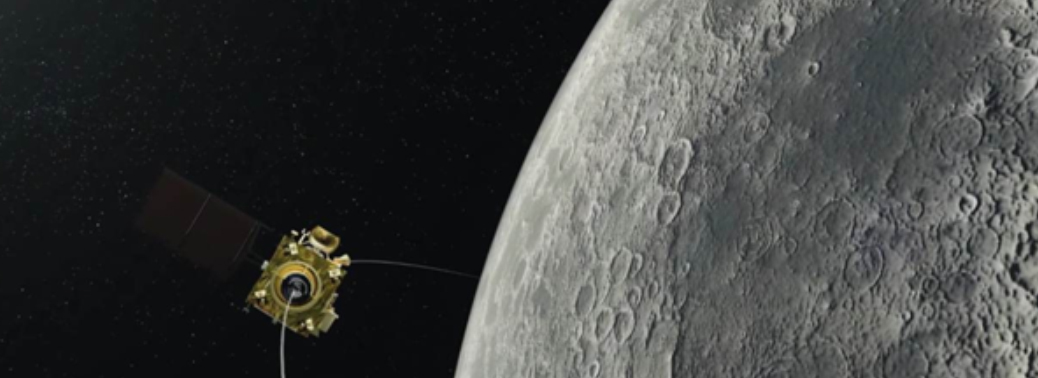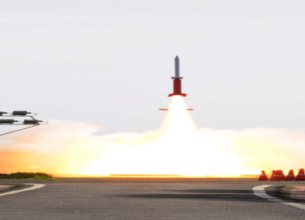CHANDRAYAAN-2 PLACED IN LUNAR ORBIT
21, Aug 2019

Prelims level : Science & Technology- Space technology
Mains level : GS-III- Awareness in the fields of IT, Space, Computers, robotics, nano-technology, bio-technology and issues relating to intellectual property rights.
Context: India’s Chandrayaan-2 mission crossed a major milestone on its journey towards the Moon, having entered a lunar orbit, almost exactly 30 days after being launched on July 22.
What exactly did Chandrayaan-2 achieve?
- After being launched, Chandrayaan-2 had been put in an elliptical orbit around the Earth.
- Until August 14, it had been going around the Earth, incrementally raising its orbit by firing boosters on five occasions.
- Eventually, it reached an orbit that was 276 km from the Earth’s surface at its closest and 142,975 km at the farthest.
- It spent nearly a week in that orbit, before firing a booster once again to break free from the Earth orbit and begin its journey towards the Moon.
- This transit from orbit to orbit happened on August 14.
- After five days of this journey, Chandrayaan-2 came sufficiently close to the Moon to experience its gravity. And on Tuesday, it entered into an orbit around the Moon.
What exactly is meant by ‘insertion into lunar orbit’?
- Just like it was going around the Earth at the start of its journey, Chandrayaan-2 is now orbiting the Moon.
- On Tuesday, it was placed into an elliptical orbit that was 114 km from the Moon’s surface at its nearest, and 18,072 km at the farthest.
- The spacecraft will carry out a few more manoeuvres to eventually place itself in a circular orbit of 100 km × 100 km around the Moon (see illustration below).
- The Lander and Rover modules will detach themselves from here and descend into lower orbits before finally making a landing on September 7.
- The main spacecraft, however, will continue to orbit the Moon in the 100 km circular orbit for at least one year, making observations through the several instruments it has on board.
Why Are These Manoeuvres Needed?
- Indeed.it is possible to fly straight to the Moon, without getting into the Earth orbits. The lunar orbit, however, cannot be avoided. The spacecraft cannot land directly on the Moon.
- In fact, none of the Apollo missions that landed astronauts on the Moon took the route that Chandrayaan-2, or all other recent missions to Moon, have taken. The Apollo missions flew directly to the Moon. But this is not considered wise or economical.
- That is because the rockets need to be extraordinarily powerful to carry the spacecraft all the way to Moon.
- An enormous amount of fuel too is required. Taking a longer route, however, makes it much easier for the spacecraft to travel.
- The rocket has to take the spacecraft only about 200 km from the Earth’s surface and deposit it in Low-Earth Orbit.
- Thereafter, the spacecraft moves around the Earth under the influence of gravity. This stable position is also a good time for ground controllers to check on the health of the equipment on board.
- While circling the Earth, a substantially lower amount of energy is required to propel the spacecraft into higher orbits due to reduction in atmospheric drag.
- This is easily possible with a small amount of fuel onboard. With each higher orbit, however, the gain in energy is enormous, enabling the spacecraft to achieve great velocities, and the power to move much deeper into space.
What happened in Apollo Mission?
- To put things in perspective, the Apollo missions were carried on giant Saturn V rockets, which even today remain the most powerful rockets ever built.
- They were 111 metres tall, higher than a modern 30-storey building, and weighed 2,800 tonnes, a significant part being contributed by the fuel it carried.
- According to information on NASA website, the fuel it burnt to land astronauts on the Moon — several million litres of liquid oxygen and liquid hydrogen in different stages — could take a normal car 800 times around the Earth. It is said to have consumed 20 tonnes of fuel every second.
Comparison with Chandrayaan 2:
- In comparison, ISRO’s GSLV Mk-III rocket used to launch Chandrayaan-2 is extremely modest.
- At 43.43 metres, it has less than half the height of Saturn V, and weighs 640 tonnes, less than one-fourth of Saturn V.
- It can carry less than 350 tonnes of fuel, roughly about one-fifth of what Saturn V needed for its Apollo missions.
Chandrayaan-2 is said to have slowed down before entering lunar orbit. Why did it need to slow down?
- Chandrayaan-2, after coming under the influence of lunar gravity on Monday, had begun to accelerate.
- At one point, it had reached a velocity of 2.4 km per second (8,640 km per hour).
- This is just about equal to the escape velocity of the Moon.
- If Chandrayaan-2 had been allowed to speed up unrestrained, it would have escaped the Moon’s gravity and moved away.
- To keep it in the lunar orbit, therefore, its velocity was brought down to 2.1 km per second (7,560 km per hour).
How do they increase or decrease speed?
- Spacecraft increase or decrease their velocities by firing on-board thrusters.
- To speed up, the thrusters are fired in a direction opposite to the motion of the spacecraft. It has an effect similar to the recoil that a gun experiences after firing. Velocity can be reduced if the thrusters are fired in the direction of motion.







